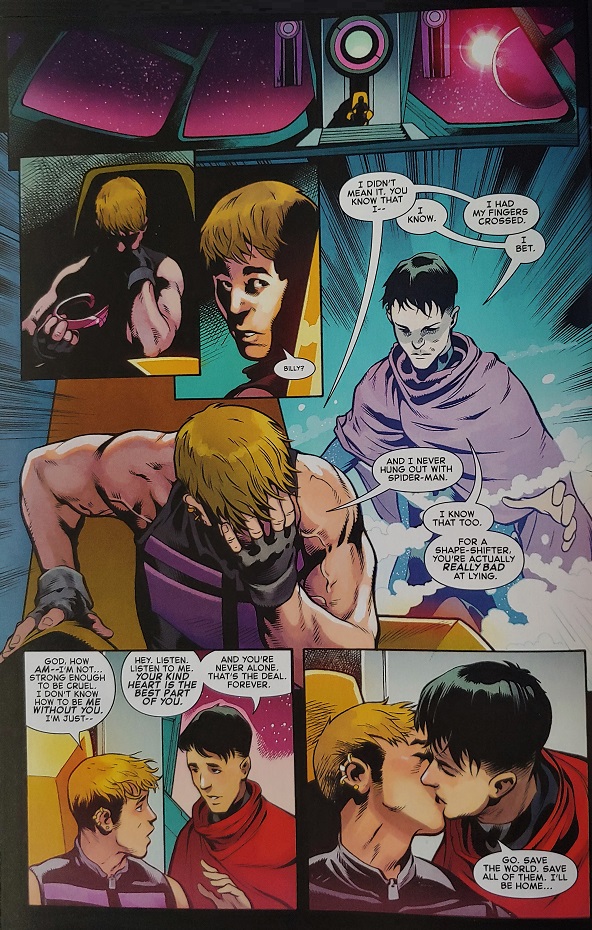In 2005 Allan Heinberg forever changed the Marvel Universe with the introduction of two amazing characters: Wiccan and Hulkling. Although portraying two gay teenage superheroes as a loving couple was quite controversial amidst the most conservative sector of Marvel readers, Heinberg never gave up and turned Young Avengers not only into one of the most successful titles but also one of the most revered and admired by fans.
 |
| Patrick Gleason |
We all knew that Billy Kaplan (Wiccan) and Teddy Altman (Hulkling) were lovers, but due to the extremely prudish mindset of some readers, we never got to see the two of them kissing on the page in the original series. We had to wait 7 years until Heinberg wrote the miniseries Avengers: the Children’s Crusade. In 2012, Billy and Teddy kissed each other for the first time.
The young heroes kissed again on multiple occasions on Kieron Gillen’s Young Avengers in 2013, proving that what was once considered controversial was no longer such a big taboo. However, for a gay couple their sex life was, shall we say, enshrouded in secrecy. Were they doing the dirty or not? I’m sure many fans were asking that question, and judging by the plethora of erotic fanfic art available online, many of them had found a way to answer that!
 |
| Teddy Altman (Hulkling) |
In “Profane the Precious Time” (originally published in Lords of Empyre: Emperor Hulkling # 1, September 2020), Chip Zdarsky and Anthony Oliveira write a fascinating story that revolves around Hulkling, his role as future emperor and most especially his relationship with Wiccan. Manuel Garcia does an amazing job as a penciler, providing sequences full of action but also more calmed moments, in which the characters can be seen as vulnerable and human as ever. Cam Smith is the inker and Triona Farrell the colorist, while the striking cover of this issue is by Patrick Gleason.
The extraordinary splash page in which we see Teddy Altman laying in bed, has a unique level of realism and grace that only Garcia could’ve accomplished. There is also a strong romantic tone in the page in which Teddy and Billy are cuddling together, overlooking the city. Of course, the moment all fans were waiting for, the moment that had inspired thousands of fanfic art, is magnificently illustrated by Garcia. Marvel’s most prominent gay couple end up making love on an alien spaceship.
However, this is more than a simple sexual encounter. Zdarsky and Oliveira create a compelling story in which love between two young men is no longer a taboo, but that doesn’t make things any easier. Wiccan belongs to our world, while Hulkling has to embrace his position as the new emperor of an alien civilization. This one shot feels just as special as Young Avengers did, and only this amazing creative team would have been able to pull that off.
________________________________________________________________________________________________________
________________________________________________________________________________________________________
El 2005, Allan Heinberg cambió para siempre el Universo Marvel con la introducción de dos personajes asombrosos: Wiccan y Hulkling. Aunque retratar a dos superhéroes adolescentes gays como una pareja amorosa fue bastante controversial entre el sector más conservador de los lectores de Marvel, Heinberg nunca se rindió y convirtió a Young Avengers no sólo en uno de los títulos más exitosos sino también en uno de los más venerados y admirados por los fans.
Todos sabíamos que Billy Kaplan (Wiccan) y Teddy Altman (Hulkling) eran amantes, pero debido a la mentalidad extremadamente mojigata de algunos lectores, nunca llegamos a verlos dos besándose en la página en la serie original. Tuvimos que esperar 7 años hasta que Heinberg escribiera la miniserie Avengers: the Children’s Crusade. El 2012, Billy y Teddy se besaron por primera vez.
Los jóvenes héroes se volvieron a besar en múltiples ocasiones el 2013, en Young Avengers de Kieron Gillen, lo que demuestra que lo que alguna vez se consideraba controversial dejó de ser un gran tabú. Sin embargo, para ser una pareja gay, su vida sexual estaba, por así decirlo, envuelta en secreto. ¿Estaban haciendo guarradas o no? Estoy seguro de que muchos fans estaban haciéndose esa pregunta y, a juzgar por la gran cantidad de fanfic art erótico disponible en línea, ¡muchos de ellos habían encontrado la manera de responder!
En “Profano el precioso tiempo” (publicado originalmente en Lords of Empyre: Emperor Hulkling # 1, setiembre de 2020), Chip Zdarsky y Anthony Oliveira escriben una historia fascinante que gira en torno a Hulkling, su papel como futuro emperador y muy especialmente su relación con Wiccan. Manuel García hace un trabajo increíble como dibujante, proporcionando secuencias llenas de acción pero también momentos más tranquilos, en los que los personajes pueden verse tan vulnerables y humanos como siempre. Cam Smith es el entintador y Triona Farrell brinda los colores, mientras que la llamativa portada de este número es de Patrick Gleason.
La extraordinaria página completa en la que vemos a Teddy Altman acostado en la cama, tiene un nivel único de realismo y gracia que solo García podría haber logrado. También hay un fuerte tono romántico en la página en la que Teddy y Billy se acurrucan, avistando la ciudad. Por supuesto, el momento que todos los fanáticos estaban esperando, el momento que había inspirado a miles de fanfic art, está magníficamente ilustrado por García. La pareja gay más destacada de Marvel acaba haciendo el amor en una nave espacial extraterrestre.
Sin embargo, esto es más que un simple encuentro sexual. Zdarsky y Oliveira crean una historia fascinante en la que el amor entre dos jóvenes ya no es un tabú, pero eso no facilita las cosas. Wiccan pertenece a nuestro mundo, mientras que Hulkling tiene que aceptar su posición como nuevo emperador de una civilización alienígena. Este cómic se siente tan especial como la colección de Young Avengers, y sólo este increíble equipo creativo habría podido lograr algo semejante.































